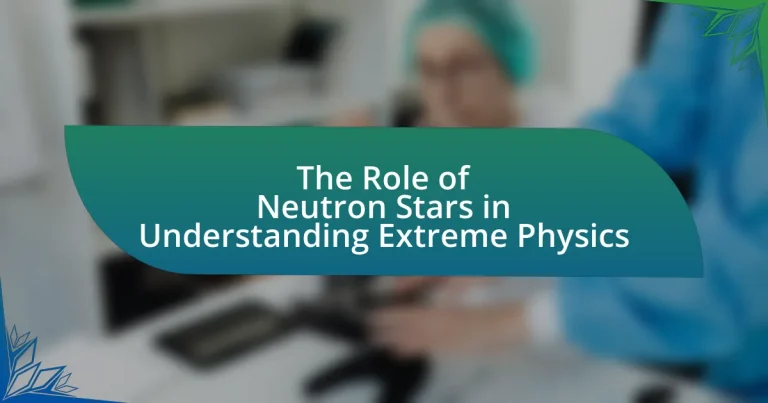Neutron stars are dense remnants formed from the core collapse of massive stars during supernova explosions, primarily composed of neutrons. They serve as critical laboratories for studying extreme physics, providing insights into fundamental aspects of matter under conditions of high density and pressure that cannot be replicated on Earth. The article explores the formation processes of neutron stars, their key characteristics, and their significance in understanding gravitational waves, nuclear interactions, and the chemical enrichment of the universe. Additionally, it discusses the technological advancements enhancing neutron star research and the unanswered questions that remain in this field, highlighting the potential implications for our understanding of fundamental physics and the universe.

What are Neutron Stars and Why are They Important in Extreme Physics?
Neutron stars are incredibly dense remnants of massive stars that have undergone supernova explosions, resulting in a core primarily composed of neutrons. Their importance in extreme physics lies in their ability to provide insights into fundamental aspects of matter under extreme conditions, such as high density and pressure, which cannot be replicated in laboratories on Earth. For instance, neutron stars exhibit phenomena like gravitational waves, as observed from neutron star mergers detected by LIGO, which confirm predictions of general relativity and enhance our understanding of the universe’s evolution. Additionally, the study of neutron star properties, such as their mass and radius, helps refine models of nuclear interactions and the behavior of matter at nuclear densities, contributing to advancements in theoretical physics.
How do Neutron Stars form?
Neutron stars form from the remnants of massive stars that undergo supernova explosions. When a star with a mass greater than approximately 8 times that of the Sun exhausts its nuclear fuel, it can no longer support itself against gravitational collapse. The core collapses under its own gravity, leading to an implosion that results in a supernova. During this process, protons and electrons combine to form neutrons, creating an extremely dense object primarily composed of neutrons. This transformation is supported by the principles of nuclear physics, which dictate that the core’s density becomes so high that neutron degeneracy pressure counteracts further collapse, stabilizing the neutron star.
What processes lead to the creation of a Neutron Star?
Neutron stars are created through the gravitational collapse of massive stars during supernova explosions. When a star with a mass greater than approximately 8 solar masses exhausts its nuclear fuel, it can no longer support itself against gravitational forces. This leads to a core collapse, where the core’s protons and electrons combine to form neutrons, resulting in an extremely dense object primarily composed of neutrons. The supernova explosion expels the outer layers of the star, while the core remains as a neutron star. This process is supported by observations of supernova remnants and the characteristics of neutron stars, which exhibit densities exceeding that of atomic nuclei, confirming their formation from such catastrophic stellar events.
What role do supernovae play in the formation of Neutron Stars?
Supernovae are critical in the formation of neutron stars, as they are the explosive end stages of massive stars that lead to the collapse of the stellar core. During a supernova explosion, if the remaining core mass is between approximately 1.4 and 3 solar masses, gravitational forces overcome electron degeneracy pressure, resulting in the core collapsing into a neutron star. This process is supported by the observation that neutron stars are often found in the remnants of supernovae, such as the Crab Nebula, which is the remnant of a supernova observed in 1054 AD. Thus, supernovae serve as the mechanism through which neutron stars are born from the remnants of massive stars.
What are the key characteristics of Neutron Stars?
Neutron stars are incredibly dense remnants of supernova explosions, primarily composed of neutrons. They typically have a mass between 1.4 and 2.16 solar masses, yet their radius is only about 10 to 12 kilometers, resulting in densities exceeding 10^17 kg/m³. Neutron stars possess strong magnetic fields, often exceeding 10^8 to 10^15 teslas, and exhibit rapid rotation, with some spinning hundreds of times per second. Additionally, they can emit beams of electromagnetic radiation, leading to the classification of some as pulsars. These characteristics are crucial for understanding fundamental physics, including the behavior of matter under extreme conditions, as they challenge existing theories of nuclear and particle physics.
How dense are Neutron Stars compared to other celestial bodies?
Neutron stars are among the densest celestial bodies, with densities exceeding 4 x 10^17 kg/m³, which is approximately 2 to 3 times the density of an atomic nucleus. This extreme density results from the gravitational collapse of massive stars, where protons and electrons combine to form neutrons. In comparison, typical stellar objects like white dwarfs have densities around 10^9 kg/m³, and ordinary matter, such as water, has a density of about 1,000 kg/m³. Thus, neutron stars are significantly denser than both white dwarfs and ordinary matter, illustrating their unique role in understanding extreme physics.
What is the significance of the strong nuclear force in Neutron Stars?
The strong nuclear force is crucial in neutron stars as it binds neutrons together, counteracting gravitational collapse. This force is responsible for the stability of neutron stars, which are composed primarily of densely packed neutrons. The balance between the strong nuclear force and gravitational forces allows neutron stars to exist in a state of equilibrium, preventing them from collapsing into black holes. Additionally, the strong nuclear force influences the star’s properties, such as its density and temperature, which can reach extreme levels, providing insights into fundamental physics and the behavior of matter under extreme conditions.
Why are Neutron Stars considered laboratories for extreme physics?
Neutron stars are considered laboratories for extreme physics because they exhibit conditions of density, gravity, and magnetic fields that cannot be replicated on Earth. These stellar remnants, formed from the collapse of massive stars, possess densities exceeding that of atomic nuclei, leading to unique states of matter such as superfluidity and superconductivity. The gravitational field of a neutron star is so intense that it warps spacetime, allowing scientists to study general relativity in extreme environments. Additionally, the strong magnetic fields, often reaching billions of times that of Earth’s, provide insights into magnetohydrodynamics and particle physics under extreme conditions. Observations of neutron stars, including pulsars and magnetars, have yielded critical data that enhance our understanding of fundamental physics, such as the behavior of matter at nuclear densities and the nature of gravity in strong fields.
What extreme conditions can be studied in Neutron Stars?
Neutron stars provide a unique environment to study extreme conditions such as ultra-high densities, intense gravitational fields, and extreme magnetic fields. The density in neutron stars can exceed 10^14 grams per cubic centimeter, which is greater than that of an atomic nucleus, allowing researchers to explore the behavior of matter under such extreme pressure. Additionally, the gravitational field near a neutron star can be about 2 billion times stronger than Earth’s gravity, enabling the study of general relativity and its effects on time and space. Furthermore, neutron stars can possess magnetic fields that are trillions of times stronger than Earth’s, which facilitates the investigation of magnetohydrodynamics and the behavior of charged particles in extreme magnetic environments. These conditions are critical for understanding fundamental physics, including the state of matter, nuclear interactions, and the behavior of gravity under extreme circumstances.
How do Neutron Stars help us understand fundamental physics concepts?
Neutron stars help us understand fundamental physics concepts by providing extreme environments where the laws of physics can be tested under conditions not replicable on Earth. Their incredibly high densities, which can exceed that of an atomic nucleus, allow scientists to study the behavior of matter at nuclear densities, contributing to our understanding of quantum chromodynamics and the strong nuclear force. Observations of neutron stars, particularly through gravitational waves and electromagnetic radiation, have confirmed aspects of general relativity, such as the effects of strong gravitational fields on time and space. Additionally, the study of pulsars, a type of neutron star, has provided insights into the nature of spacetime and the limits of our current physical theories, including the search for a unified theory of gravity and quantum mechanics.

How do Neutron Stars contribute to our understanding of the universe?
Neutron stars contribute to our understanding of the universe by serving as natural laboratories for studying extreme states of matter and fundamental physics. Their incredibly dense composition, resulting from the collapse of massive stars, allows scientists to explore conditions that cannot be replicated on Earth, such as the behavior of nuclear matter at densities exceeding that of an atomic nucleus. Observations of neutron stars, particularly through gravitational waves and electromagnetic radiation, have provided insights into phenomena like the equation of state of dense matter, the nature of gravity, and the formation of heavy elements through processes like neutron capture. For instance, the detection of gravitational waves from neutron star mergers has confirmed predictions of general relativity and has also linked these events to the production of heavy elements like gold and platinum, thereby enhancing our understanding of cosmic nucleosynthesis.
What role do Neutron Stars play in the study of gravitational waves?
Neutron stars play a crucial role in the study of gravitational waves by serving as key sources of these waves during events such as neutron star mergers. When two neutron stars collide, they generate significant gravitational waves that can be detected by observatories like LIGO and Virgo. The first direct detection of gravitational waves in 2015 was from a binary black hole merger, but subsequent observations, including the landmark event GW170817 in 2017, confirmed that neutron star mergers also produce detectable gravitational waves. This event provided not only gravitational wave data but also electromagnetic signals, allowing for multi-messenger astronomy, which enhances our understanding of the universe’s most extreme phenomena.
How are Neutron Star mergers detected and what do they reveal?
Neutron star mergers are detected primarily through gravitational wave observatories like LIGO and Virgo, which identify the ripples in spacetime caused by these cataclysmic events. The first confirmed detection of a neutron star merger, designated GW170817, occurred on August 17, 2017, and was accompanied by electromagnetic signals across various wavelengths, including gamma rays, X-rays, and optical light, providing a multi-messenger astronomy approach.
These mergers reveal critical information about the behavior of matter under extreme conditions, the formation of heavy elements through nucleosynthesis, and the dynamics of compact objects. The observation of kilonova emissions from GW170817 confirmed that neutron star mergers are a significant source of heavy elements like gold and platinum in the universe, thus enhancing our understanding of cosmic chemical evolution.
What insights do we gain from the electromagnetic signals of Neutron Stars?
Electromagnetic signals from neutron stars provide critical insights into their structure, composition, and the fundamental physics governing extreme environments. These signals, particularly in the radio, X-ray, and gamma-ray wavelengths, allow scientists to study phenomena such as pulsar timing, which reveals information about the neutron star’s rotation and magnetic field strength. For instance, the detection of gravitational waves from neutron star mergers, combined with electromagnetic observations, has confirmed the production of heavy elements like gold and platinum, demonstrating the role of neutron stars in nucleosynthesis. Additionally, the study of X-ray emissions from accreting neutron stars helps in understanding the state of matter under extreme densities, supporting theories of quantum chromodynamics and the behavior of matter in extreme gravitational fields.
How do Neutron Stars influence the evolution of galaxies?
Neutron stars influence the evolution of galaxies primarily through their role in supernova explosions and the subsequent distribution of heavy elements. When massive stars exhaust their nuclear fuel, they undergo supernova events, leading to the formation of neutron stars. These explosions eject significant amounts of material into the interstellar medium, enriching it with heavy elements like iron and nickel, which are crucial for the formation of new stars and planets.
Additionally, neutron stars can emit powerful jets and radiation, impacting the surrounding gas and dust, which can trigger star formation or inhibit it depending on the energy and direction of the emissions. Observations indicate that regions with neutron star activity often show enhanced star formation rates due to the shock waves generated by supernovae. This interplay between neutron stars and their environments is essential for understanding the chemical evolution of galaxies and the lifecycle of stellar populations.
What is the impact of Neutron Stars on stellar populations?
Neutron stars significantly influence stellar populations by acting as endpoints of massive stars and contributing to nucleosynthesis. When massive stars undergo supernova explosions, they can leave behind neutron stars, which are remnants that affect the surrounding interstellar medium. This process enriches the medium with heavy elements, as neutron stars can facilitate the rapid neutron capture process (r-process), leading to the formation of elements like gold and platinum. Studies have shown that the presence of neutron stars in a galaxy can alter the chemical composition and evolution of stellar populations, impacting star formation rates and the overall metallicity of the galaxy.
How do Neutron Stars contribute to the chemical enrichment of the universe?
Neutron stars contribute to the chemical enrichment of the universe primarily through the process of nucleosynthesis during supernova explosions and neutron star mergers. When massive stars exhaust their nuclear fuel, they undergo supernova events, ejecting heavy elements such as iron and nickel into the interstellar medium. Additionally, when two neutron stars collide, they produce heavy elements like gold and platinum through rapid neutron capture processes, known as r-process nucleosynthesis. Observations of gravitational waves from neutron star mergers, such as the event GW170817, have confirmed the production of these heavy elements, demonstrating their significant role in enriching the universe’s chemical composition.

What are the future directions in Neutron Star research?
Future directions in neutron star research include the study of gravitational waves, the exploration of neutron star mergers, and the investigation of the equation of state for dense matter. Gravitational wave astronomy, particularly from events like neutron star collisions, provides insights into the fundamental physics of these objects and their role in the universe. Research into neutron star mergers, such as those detected by LIGO and Virgo, helps to understand the formation of heavy elements and the behavior of matter under extreme conditions. Additionally, determining the equation of state for neutron-rich matter is crucial for understanding the internal structure of neutron stars, which can be explored through observations of pulsars and the analysis of their mass and radius. These areas of research are supported by advancements in observational technology and theoretical modeling, enhancing our understanding of extreme physics.
What technological advancements are enhancing Neutron Star studies?
Technological advancements enhancing Neutron Star studies include gravitational wave detectors, advanced radio telescopes, and high-energy particle accelerators. Gravitational wave detectors, such as LIGO and Virgo, have enabled the observation of neutron star mergers, providing insights into their properties and the formation of heavy elements. Advanced radio telescopes, like the Square Kilometre Array, improve the detection of pulsars and the study of neutron star magnetic fields. High-energy particle accelerators, such as the Large Hadron Collider, simulate conditions similar to those found in neutron stars, allowing researchers to explore the behavior of matter under extreme densities and temperatures. These technologies collectively contribute to a deeper understanding of the fundamental physics governing neutron stars.
How do new telescopes and observatories improve our observations?
New telescopes and observatories enhance our observations by utilizing advanced technologies that increase sensitivity and resolution. For instance, the James Webb Space Telescope employs infrared capabilities to detect faint light from distant celestial objects, allowing astronomers to study the formation of stars and galaxies in unprecedented detail. Additionally, ground-based observatories like the Extremely Large Telescope utilize adaptive optics to correct atmospheric distortions, resulting in clearer images of astronomical phenomena. These advancements enable scientists to gather more accurate data, leading to deeper insights into the nature of neutron stars and their role in extreme physics.
What role does computational modeling play in Neutron Star research?
Computational modeling plays a crucial role in neutron star research by simulating the extreme physical conditions present in these celestial objects. These models allow scientists to explore the behavior of matter under unprecedented densities and temperatures, which cannot be replicated in laboratory settings. For instance, computational simulations help in understanding the equation of state of neutron-rich matter, which is essential for predicting neutron star properties such as mass, radius, and cooling mechanisms. Research conducted by Lattimer and Prakash in 2001 demonstrated how different equations of state influence neutron star structure, providing a framework for interpreting observational data from sources like gravitational waves and X-ray emissions. Thus, computational modeling is integral to advancing our understanding of the fundamental physics governing neutron stars.
What unanswered questions remain in the study of Neutron Stars?
Unanswered questions in the study of neutron stars include the precise nature of their internal structure, the mechanisms behind their powerful magnetic fields, and the processes that govern their formation and evolution. Research indicates that the equation of state for neutron-rich matter remains uncertain, impacting our understanding of neutron star masses and radii. Additionally, the origin of fast radio bursts, which may be linked to neutron stars, is still not fully understood, highlighting gaps in knowledge regarding their astrophysical phenomena. These questions are critical for advancing our comprehension of extreme physics and the fundamental properties of matter under extreme conditions.
What mysteries about Neutron Stars are scientists currently investigating?
Scientists are currently investigating several mysteries about neutron stars, including their internal structure, the nature of their dense matter, and the mechanisms behind their powerful magnetic fields. Research indicates that the equation of state for neutron star matter remains uncertain, which affects our understanding of their mass and radius. Additionally, the origins and behavior of pulsar glitches, sudden changes in rotation speed, are under scrutiny, as they may reveal insights into the superfluid interior of these stars. Studies also focus on the formation of neutron stars in supernova explosions and the role of neutron star mergers in producing heavy elements, as evidenced by gravitational wave detections from events like GW170817.
How might future discoveries change our understanding of extreme physics?
Future discoveries, particularly related to neutron stars, could significantly enhance our understanding of extreme physics by revealing insights into the behavior of matter under extreme conditions. Neutron stars, with their incredibly dense cores, serve as natural laboratories for studying the fundamental forces and interactions that govern the universe. For instance, advancements in gravitational wave astronomy, such as those from the LIGO and Virgo collaborations, have already provided evidence of neutron star mergers, which can inform theories about nuclear matter and the equation of state at high densities. Additionally, observations from telescopes like the NICER (Neutron star Interior Composition Explorer) can help measure the mass and radius of neutron stars, leading to better models of their internal structure and the extreme physics involved. These discoveries could challenge existing theories and lead to new physics beyond the current understanding, such as insights into dark matter or the unification of forces.
What practical implications do Neutron Star studies have for science and technology?
Neutron star studies have significant practical implications for science and technology, particularly in advancing our understanding of fundamental physics and developing new technologies. Research on neutron stars enhances knowledge of extreme states of matter, which can lead to breakthroughs in materials science, such as the creation of new materials with unique properties. For instance, the study of neutron star collisions has provided insights into the formation of heavy elements, which can inform nuclear physics and astrophysics. Additionally, the gravitational waves detected from neutron star mergers have spurred advancements in detection technologies, influencing fields like telecommunications and precision measurement. These studies also contribute to the development of theoretical models that can be applied in various scientific domains, including cosmology and quantum mechanics.




